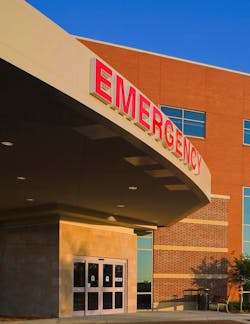3 keys to designing freestanding emergency departments
For the vast majority of patients, emergency care has traditionally been delivered in a centrally-located hospital emergency department at the nucleus of a given local health system.
However, the Affordable Care Act has spurred a focus on emergency care at the fringes of a health system’s reach, and more organizations are turning to a satellite system of freestanding emergency departments (FEDs) to provide care in underserved areas, capture additional market share, reduce ED overcrowding and wait times, and accelerate their healthcare reform initiatives.
Unlike freestanding clinics or urgent care facilities, FEDs offer all of the services typically associated with a hospital ED, adhere to the same design codes and standards, and are staffed 24/7 by doctors and nurses specializing in emergency care.
The concept is not new, but it has been fairly marginal until recently. Estimates record 55 FEDs in the U.S. in 1978, 146 in 2004, and 256 in 2010-a 75% increase in only six years.
Since 2010, as the ACA has rolled out, demand has only grown and numerous FEDs are under construction around the country. One publication even termed FEDs "a medical facility fitting for healthcare reform", citing the creation of new access points with minimal capital investment and increases in ED throughput.
More Posts from the GS&P Dialogue blog
Let the Sun Shine In: Incorporating Daylighting Strategies in Industrial FacilitiesBeauty and the Bioswale: How Sustainability is Redefining Landscape Architecture
Defeating Disaster Part I: Climate Changes Demand Preparation
FEDs average 30 minutes from door-to-doctor and 90 minutes from door-to-discharge, while traditional EDs average 60 minutes and 180 minutes respectively. Associated savings in patient and hospital costs and overall increases in patient satisfaction are certainly significant, but they are by no means guaranteed.
Having physically disassociated from a central hospital, FEDs must overcome the particular challenges associated with a satellite location- namely, a lack of awareness and a lack of appeal and credibility. Faced with these challenges, good design becomes critically important to a FED's success with both patients and staff.
Here are three keys to remember:
1. Site Selection
For FEDs, the importance of site selection really cannot be understated. Sites located close to interstates and major thoroughfares will attract patients and streamline emergency vehicle access.
Retail areas are often a good choice, as they are usually well-positioned in convenient, high-traffic areas. However, it can be difficult to meet hospital codes on such a site. A strong engineering and design team can help providers identify problem areas that need correction and determine if a site is useable.
2. Wayfinding
Emergencies leave little room for navigational error and wayfinding leading up to a FED must be as simple and intuitive as possible. Building orientation should maximize site views from nearby interstates and major roads so that patients can easily spot the facility as they are driving in.
In addition to clear signage from the interstate to the front door, the FED’s exterior should provide immediate visual cues separating it from any surrounding retail. Though different with each site, cues could include a taller façade and larger entranceway, a monumental sign consistent with the hospital’s brand, or a glassed-in lobby.
3. Appealing Interiors
To meet stringent codes, the layout and equipment in patient rooms and treatment areas will be fairly similar to hospital-based EDs. However, the more compact nature of FEDs can make upscale finishes more viable, and the payoff can be significant.
For patients, a well-appointed environment with elegant finishes is reassuring and can create an overall impression of satisfaction, cleanliness and efficiency. For staff, high-quality interiors provide extra inducement to leave their current situations for the new FED and can help ease the transition for those reluctant to leave the centralized hospital activity that they are accustomed to.
Designed with these factors in mind, FEDs can avoid becoming yet another capital drain on already overburdened systems, and can instead become thriving outposts and fiscally sound investments for hospitals seeking to differentiate themselves as they adapt to the precepts of healthcare reform.
Are health systems in your area considering FEDs? Do you see them as a viable solution? Let us know in the comments.
About the Author
Kristin Herman-Druck, RA, AIA, has more than 14 years of healthcare experience in programming, conceptual design, schematic design and presentation preparation, design critiques and development, construction documents, bidding and negotiations, and construction administration. Her relationships with clients and contractors help provide successful projects to the facilities and the South Florida community. More
About the Author
Gresham Smith
The Gresham Smith blog is about starting discussions. We want to get people thinking about issues and trends that are impacting the design services industry and the market sectors Gresham Smith architects, engineers, interior designers, planners, consultants and environmental scientists serve. Great ideas are typically enhanced through conversation and often stifled by singular views and opinion. We hope you'll join in this conversation and help us to create a meaningful dialogue. Follow us on Facebook, Instagram, LinkedIn, Twitter, Vimeo, and YouTube.
